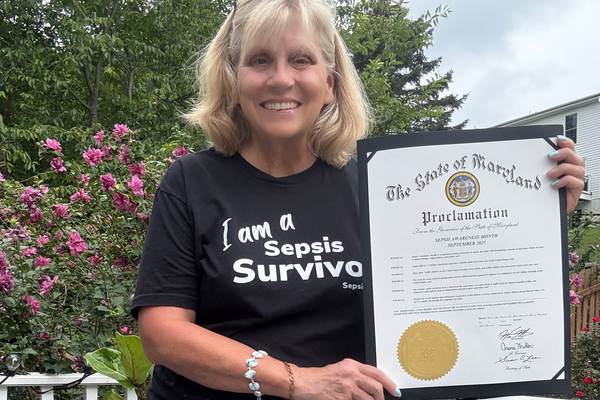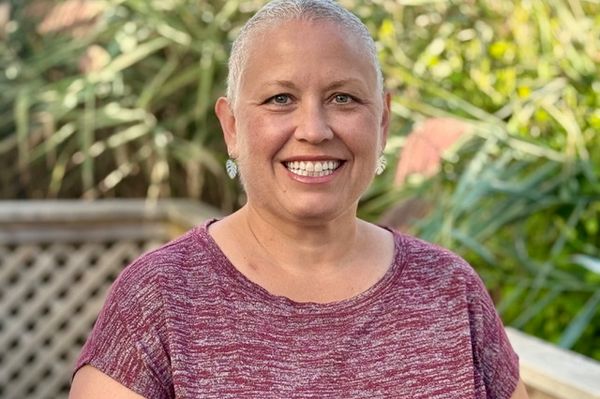Candace was just 13 years old when she was crippled with the most intense pain she had ever felt. Doubled over on the floor and vomiting, she said that "it felt like burning, like fire, like the sharpest thing you could imagine."
Over the next couple of decades, bright sunshine and lights caused Candace's skin to feel as though it was on fire, and she suffered from multiple mysterious, debilitating and painful episodes. After many misdiagnoses and several unnecessary surgeries — some patients even receive misdiagnoses of appendicitis, sinus tachycardia, gastritis or partial intestinal obstruction — she was finally diagnosed with hereditary coproporphyria (HCP), which is a form of acute hepatic porphyria associated with skin manifestations such as painful redness, swelling, blisters and sensitivity to light.
If you're unfamiliar with Candace's diagnosis, you're not alone. Acute hepatic porphyria, or AHP, refers to a family of rare, genetic diseases, characterized by debilitating and painful attacks that can be life threatening or require hospitalizations. Some people also experience chronic pain and other symptoms between attacks, further impacting their ability to function and quality of life.
Although Candace did finally receive an accurate diagnosis, she said that "years of my life have been wasted away being sick — so much time has been taken away from me." Women are at least three times more likely than men to experience an acute attack and over 80% of patients who report symptoms of AHP are women between the ages of 15 and 45 — unfortunately, just like Candace, many of them suffer for years without knowing the cause. Due to very nonspecific signs and symptoms that result in a delay in testing for AHP, it may take up to 15 years to get an accurate diagnosis.
What exactly is AHP? What are the symptoms and what factors can trigger an attack? How is AHP diagnosed and what are some of the methods for keeping attacks at bay? Understanding the answers to these questions and raising awareness about AHP may lead to earlier diagnoses and treatment plans for many women, helping to potentially decrease attacks.
An "enigma of medicine"
While severe, unexplained abdominal pain is the most common symptom, occurring in more than 90% of people who experience AHP attacks, affected individuals may also experience nausea, vomiting, seizures, confusion, anxiety and depression. These symptoms — often recurring — are just a few of the myriad health issues that impact people living with AHP, and they often mimic those of more common neurological, gastrointestinal, gynecological or neuropsychiatric conditions.
Acute hepatic porphyria stems from dysfunction in the process that creates heme, which is essential for our bodies to function properly. For people who have AHP, the heme pathway in the liver doesn't work properly. This can cause a buildup of toxic substances called porphobilinogen (PBG) and aminolevulinic acid (ALA) — these toxins spread through the body and attack nerve cells, and are thought to cause damage to the nervous system, causing AHP attacks and other disease symptoms.
Each of the four types of AHP is associated with distinct enzyme defects in the liver's heme biosynthesis pathway leading to four distinct clinical entities: acute intermittent porphyria (AIP), variegate porphyria (VP), ALA dehydratase-deficiency porphyria (ADP) and hereditary coproporphyria (HCP).
Getting a diagnosis is difficult, but not impossible
Dr. Ruchika Goel, who is an assistant professor of internal medicine and pediatrics in the Division of Hematology/Oncology at the Simmons Cancer Institute at SIU School of Medicine as well as an adjunct assistant professor in the Division of Transfusion Medicine at Johns Hopkins University, said that the difficulties in diagnosing AHP makes it "an enigma of medicine."
Taking a test for AHP is actually a pretty simple process, as a random urine test (which is urine collected at any time of the day) is all that is needed to check for levels of porphyrins, porphobilinogen (PBG) and aminolevulinic acid (ALA). Fecal, blood and genetic testing can also help lead to a diagnosis and determine the type of AHP with which a patient is living.
Unfortunately, it's difficult for many women to obtain one of these simple tests. First, AHP is a rare condition and may not be top of mind. The challenges associated with diagnosis are further compounded by the non-specific symptoms of AHP, which often overlap with many other, more common conditions.
In addition, historically, research has shown that women's pain has been taken less seriously by doctors than men's pain, and symptoms of AHP, like pain, often go unacknowledged, meaning that many women need to fight even harder to be taken seriously by medical professionals. Like Candace, Megan is another woman living with AHP who received many misdiagnoses and still didn't have any clear answers after seeing at least two dozen specialists. Over time, people in her community even started to doubt the authenticity of her symptoms, which made her feel more alone. Thankfully, Megan was persistent, and she eventually found a doctor who carefully reviewed her entire medical history and tested her for AHP. Other people who have lived with undiagnosed pain and similar symptoms and haven't received a proper diagnosis may want to talk to their providers about getting tested for AHP.
Learning triggers can be key to managing symptoms
There is no cure for AHP, but Goel said that "half the game is won if you know how to prevent the triggers that lead to attacks."
Triggers vary from person-to-person and may include certain medications, stress, alcohol, extreme dieting, smoking and excessive sunlight exposure, the latter of which can cause symptoms in patients who have either variegate porphyria or HCP. For women, fluctuating levels of hormones, such as estrogen and progesterone, may also serve as triggers.
People with AHP should also learn the signs of an imminent attack — some people, for example, may feel anxious or confused, while others may experience limb weakness, fatigue, rapid heart rate or difficulty breathing.
Goel says that it's "important to understand that mental symptoms can be just as challenging as physical symptoms," and that they may even mirror symptoms of mental illness. In cases such as this, it's important to not only educate patients, but families and caretakers of people living with AHP who can also serve as advocates.
In addition to getting a good handle on triggers, people living with AHP will want to speak with their doctors about the best treatment options. Goel said that patients should regularly communicate with their physicians about their signs and symptoms. Together, a doctor and patient can come up with a treatment plan.
Candace said her "chronic pain never goes away," but that with the right team of doctors, it's possible to live as normal and rich a life as possible. "That's my goal in life," she says, "to go back to work and do a lot of the things I want to do."
For more information about AHP, please talk to your health care provider and visit www.PinpointAHP.com
This resource was created with the support of Alnylam Pharmaceuticals, Inc. AS1-USA-00704
This information is provided for educational purposes only. It is not intended to replace discussions with a healthcare provider.





